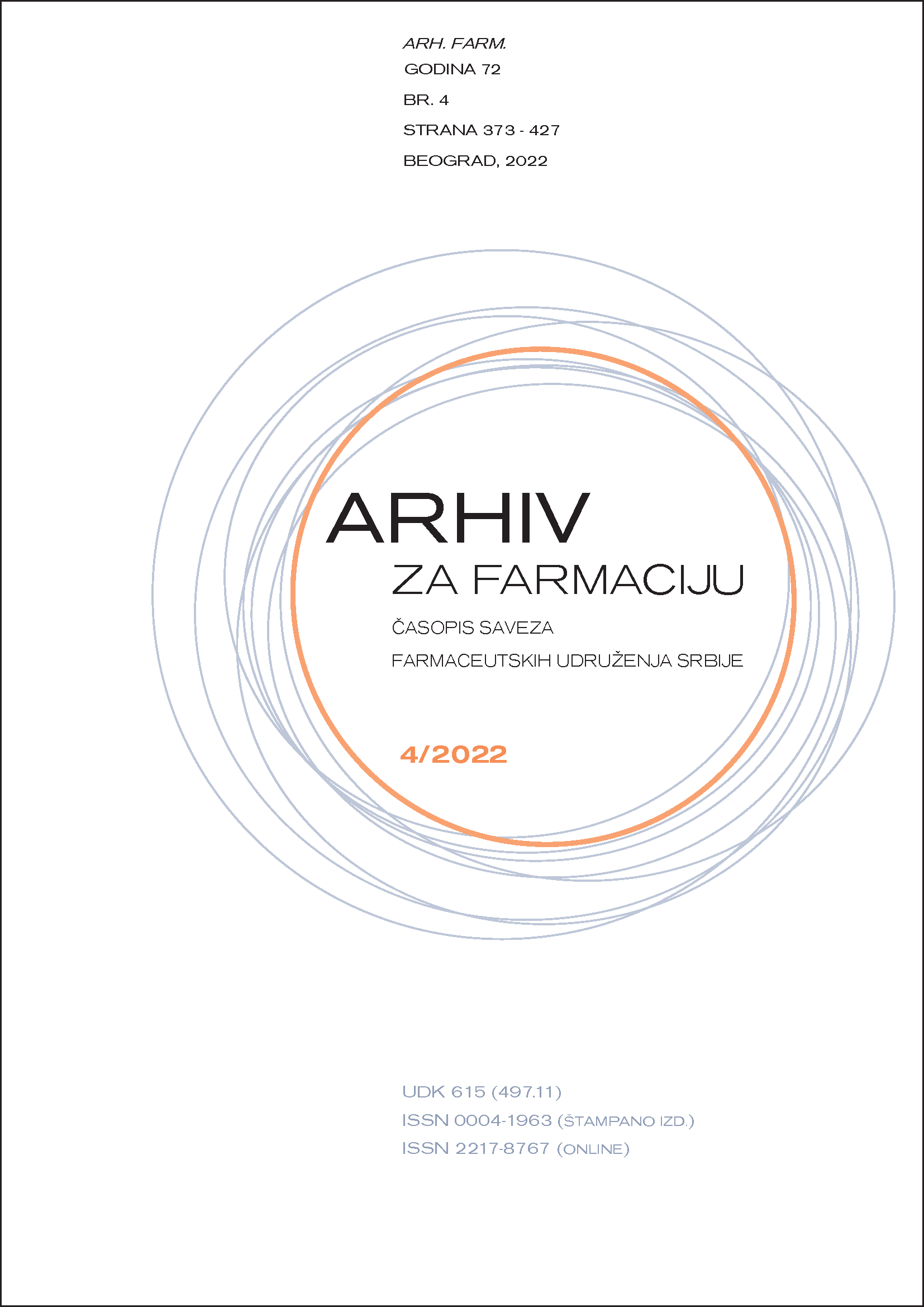Pregled razvoja i mogućnosti upotrebe SMAC mimetika: Da li se radi o magičnom oružju u lečenju karcinoma?
Sažetak
Izostanak apoptoze dovodi do preživljavanja i nekontrolisanog umnožavanja ćelija karcinoma. Istraživači koji se bave opštim i kliničkim ispitivanjima proučavali su mnoštvo centralnih regulatora apoptoze. SMAC/DIABLO (sekundarni mitohondrijski proizveden aktivator kaspaze) privukao je izuzetnu pažnju zahvaljujući izvanrednoj sposobnosti da izazove apoptotičku smrt. Stoga različiti timovi interdisciplinarnih istraživača rade na razvoju i usavršavanju SMAC mimetika koji bi mogli značajno da inhibiraju rast primarnih i sekundarnih tumora.
Reference
Oskarsson T, Batlle E, Massague J. Metastatic stem cells: sources, niches, and vital pathways. Cell Stem Cell. 2014;14(3):306–321.
Rankin EB, Giaccia AJ. Cellular Microenvironment and Metastases. In: Niederhuber JE, Armitage JO, Doroshow JH, Kastan MB, Tepper JE. 6th edition. Abeloff’s Clinical Oncology. Elsevier Inc; 2020; p. 47–55.e3. doi:10.1016/b978-0-323-47674-4.00003-7.
Thiery JP, Acloque H, Huang RY, Nieto MA. Epithelial-mesenchymal transitions in development and disease. Cell. 2009 Nov 25;139(5):871-90.
Weinberg RA. Cancer: A Genetic Disorder. In: Mendelsohn AC, Howley A, Israel S, Gray JE, Lindsten T, editors. The Molecular Basis of Cancer. Philadelphia: Elsevier; 2008; p. 3-16.
Bric A, Miething C, Bialucha CU, Scuoppo C, Zender L, Krasnitz A, et al. Functional identification of tumor-suppressor genes through an in vivo RNA interference screen in a mouse lymphoma model. Cancer Cell. 2009;16:324–335.
Burkhart DL, Sage J. Cellular mechanisms of tumour suppression by the retinoblastoma gene. Nat Rev Cancer. 2008;8:671–682.
Page-McCaw A, Ewald AJ, Werb Z. Matrix metalloproteinases and the regulation of tissue remodelling. Nat Rev Mol Cell Biol. 2007 Mar;8(3):221-33.
Graham TA, Weaver C, Mao F, Kimelman D, Xu W. Crystal structure of a beta-catenin/Tcf complex. Cell. 2000;103:885-896.
Hanahan D, Coussens LM. Accessories to the crime: functions of cells recruited to the tumor microenvironment. Cancer Cell. 2012;21(3):309–322.
Mani SA, Guo W, Liao MJ, Eaton EN, Ayyanan A, Zhou AY, et al. The epithelial-mesenchymal transition generates cells with properties of stem cells. Cell. 2008 May 16;133(4):704-15.
Zetter BR. Angiogenesis and tumor metastasis. Annu Rev Med. 1998;49:407-424.
Hurwitz HI. Introduction: targeting angiogenesis in cancer therapy. The Oncologist. 2004;9:1.
Kim J, Yao F, Xiao Z, Sun Y, Ma L. MicroRNAs and metastasis: small RNAs play big roles. Cancer Metastasis Rev. 2018 Mar;37(1):5-15.
Zobel K, Wang L, Varfolomeev E, Franklin MC, Elliott LO, Wallweber HJ, et al. Design, synthesis, and biological activity of a potent Smac mimetic that sensitizes cancer cells to apoptosis by antagonizing IAPs. ACS Chem Biol. 2006 Sep 19;1(8):525-33.
Gaither A, Porter D, Yao Y, Borawski J, Yang G, Donovan J, et al. A Smac mimetic rescue screen reveals roles for inhibitor of apoptosis proteins in tumor necrosis factor-alpha signaling. Cancer Res. 2007 Dec 15;67(24):11493-8.
Sun H, Nikolovska-Coleska Z, Yang CY, Xu L, Liu M, Tomita Y, et al. Structure-based design of potent, conformationally constrained Smac mimetics. J Am Chem Soc. 2004 Dec 29;126(51):16686-7.
Binder PS, Hashim YM, Cripe J, Buchanan T, Zamorano A, Vangveravong S, et al. The targeted SMAC mimetic SW IV-134 augments platinum-based chemotherapy in pre-clinical models of ovarian cancer. BMC Cancer. 2022 Mar 12;22(1):263.
Singh T, Neal A, Dibernardo G, Raheseparian N, Moatamed NA, Memarzadeh S. Efficacy of birinapant in combination with carboplatin in targeting platinum resistant epithelial ovarian cancers. Int J Oncol. 2022 Mar;60(3):35.
Lalaoui N, Merino D, Giner G, Vaillant F, Chau D, Liu L, et al. Targeting triple-negative breast cancers with the Smac-mimetic birinapant. Cell Death Differ. 2020;27:2768–2780.
Ding J, Qin D, Zhang Y, Li Q, Li Y, Li J. SMAC mimetic birinapant inhibits hepatocellular carcinoma growth by activating the cIAP1/TRAF3 signaling pathway. Mol Med Rep. 2020 Mar;21(3):1251-1257.
Yang L, Kumar B, Shen C, Zhao S, Blakaj D, Li T, et al. LCL161, a SMAC-mimetic, Preferentially Radiosensitizes Human Papillomavirus-negative Head and Neck Squamous Cell Carcinoma. Mol Cancer Ther. 2019 Jun;18(6):1025-1035.
Hernandez LF, Dull AB, Korrapati S, Annunziata CM. Smac-mimetic enhances antitumor effect of standard chemotherapy in ovarian cancer models via Caspase 8-independent mechanism. Cell Death Discov. 2021;7:134.
Zhang B, Yang C, Wang R, Wu J, Zhang Y, Liu D, et al. OTUD7B suppresses Smac mimetic-induced lung cancer cell invasion and migration via deubiquitinating TRAF3. J Exp Clin Cancer Res. 2020;39:244.
Majorini MT, Manenti G, Mano M, De Cecco L, Conti A, Pinciroli P, et al. cIAP1 regulates the EGFR/Snai2 axis in triple-negative breast cancer cells. Cell Death Differ. 2018 Dec;25(12):2147-2164.
Shekhar TM, Burvenich IJG, Harris MA, Rigopoulos A, Zanker D, Spurling A, et al. Smac mimetics LCL161 and GDC-0152 inhibit osteosarcoma growth and metastasis in mice. BMC Cancer. 2019 Sep 14;19(1):924.
- Autori zadržavaju autorska prava i pružaju časopisu pravo prvog objavljivanja rada i licenciraju ga "Creative Commons Attribution licencom" koja omogućava drugima da dele rad, uz uslov navođenja autorstva i izvornog objavljivanja u ovom časopisu.
- Autori mogu izraditi zasebne, ugovorne aranžmane za neekskluzivnu distribuciju članka objavljenog u časopisu (npr. postavljanje u institucionalni repozitorijum ili objavljivanje u knjizi), uz navođenje da je članak izvorno objavljen u ovom časopisu.
- Autorima je dozvoljeno i podstiču se da postave objavljeni članak onlajn (npr. u institucionalni repozitorijum ili na svoju internet stranicu) pre ili tokom postupka prijave rukopisa, s obzirom da takav postupak može voditi produktivnoj razmeni ideja i ranijoj i većoj citiranosti objavljenog članka (Vidi Efekti otvorenog pristupa).

